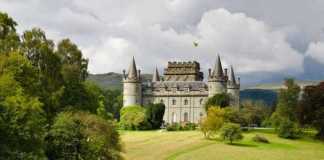Spending Christmas in a country away from home can be an equally daunting and beautiful experience. Christmas traditions vary across countries, and none more so than in Spain. Spain is a proud country with residents fiercely loyal to their Comunidades Autónomas, or autonomous regions. Regions such as Catalonia and Basque Country even have their own languages.
Many Christmas traditions across Spain’s regions are based on unique moments in history that have been passed down through generations. Spain is a great place to spend the festive period in unique, beautiful and insightful surroundings thanks to its varied culture.
Spain celebrates twice during the festive period. Once on Christmas Day and once on Three Kings Day. Spanish children will often receive presents on both days, however, the desire to receive gifts from the Three Kings Day is far greater than Santa Claus. This complete guide to spending Christmas in Spain is everything you need to know about traditions, food, and the best places to visit.
Contents
Christmas In Spain
Christmas Traditions
1- Three Kings Day
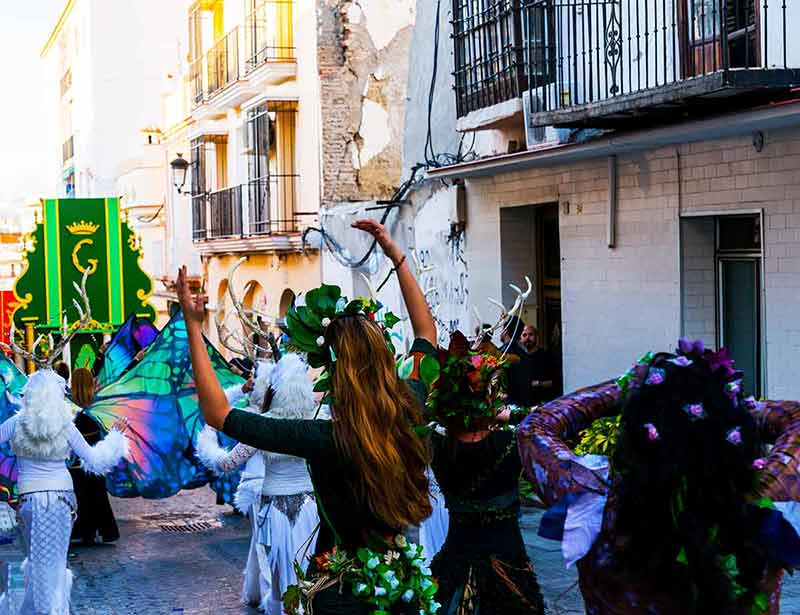
Three Kings Day is celebrated across Spain and falls on Epiphany each year.
Unlike in other Christian countries, the main Christmas holiday day is not 25 December but 6 January.
This holiday celebrates the day the baby Jesus received gifts from the Three Kings.
Children across Spain and Spanish-speaking countries wake up on Three Kings Day to presents brought by the kings.
The celebrations aren’t just kept to the home, however.
Across Spain, cities, towns and small villages will decorate the streets with lights and colourful decorations ahead of the annual Three Kings Day parades.
Parades in Madrid and Barcelona attract thousands of people and are also televised.
Parades always feature large floats dedicated to each of the Three Kings.
The kings throw colourfully wrapped sweets out into the crowds for children, and grownups alike, to catch.
Parades are typically held during the evening of 5 January.
After watching a parade and eating dinner with their families, children will clean their shoes and leave them out for the Kings to fill with gifts.
2- Caga Tió
Caga Tió is a Catalonian tradition and Christmas decoration all rolled into one. Caga Tió translates to poop log.
While this may not seem festive to some, it is a core part of Catalonian Christmas traditions, particularly for families.
The friendly-faced log is dressed up with a blanket that covers its back and reaches down to the surface it is placed on.
It also wears a barretina, a traditional Catalan hat.
Children will feed the Caga Tió by placing offerings of bread or orange peel in front of the log each evening in the lead-up to Christmas.
This aims to fatten up the log so it will give more sweets to the children.
On Christmas Eve or Christmas Day, for some, the children will sing a song about Caga Tió and hit the log with a stick, asking it to pop out treats such as sweets and traditional turron.
When they finish singing, the blanket is removed from Caga Tió and the sweets are hidden.
3- Midnight Mass
Midnight Mass is an important part of Christmas traditions in Spain.
As the country is largely Catholic, many families will head to church on Christmas Eve to participate in a Midnight Mass service.
Christmas Eve Midnight Mass is known as La Misa del Gallo or the Mass of the rooster, based on the belief that a rooster crowed the night Jesus Christ was born.
Many Spanish families will eat their main Christmas meal before or after Mass.
Midnight Mass is a great way to bring families together during the festive period.
4- Bonfires
Across the region of Andalusia, bonfires are lit to celebrate Christmas. The most famous of these bonfires are in Granada and Jaén.
Hogueras de Navidad, or Christmas Bonfires, are held during the Winter Solstice a few days before Christmas.
Locals believe jumping over the bonfire flames will bring them good health in the new year.
5- Día de los Santos Inocentes
Día de los Santos Inocentes, or Holy Innocents’ Day, is celebrated on 28 December and is a tradition based on Catholicism that evolved for the modern world.
Día de los Santos Inocentes is like April Fool’s Day, where people play pranks and tell each other jokes throughout the day.
If you are the unfortunate recipient of a prank, the prankster will shout, ‘Inocente, inocente!’.
6- El Arrastre
El Arrastre is a Christmas tradition from the southern city of Cádiz.
Every 5 January, the day before Three Kings Day, children in Cádiz tie empty cans to ropes and drag them around the streets.
The noise from the cans is to remind the Three Kings to leave presents for the children that night.
Local legend also tells of a Christmas present saboteur.
As well as using the cans to create noise for the Three Kings, it is also to scare away a mythical giant.
The giant tries each year to cover the skies in clouds of smoke to prevent the Kings from delivering presents to the children.
7- El Gordo
El Gordo is the most exciting Spanish Christmas tradition for residents.
El Gordo, or the Fat One, is the nickname of the Spanish Christmas Lottery, which is drawn on 22 December every year, offering winners huge cash prizes.
It has been held every year since 1812.
Each ticket costs €200 however, tickets are often sold in décimos, or one-tenth of a ticket, which costs €20.
As a result, many people go in together to buy one full ticket to split the winnings equally between them.
Families, friends, colleagues, and even entire villages sometimes go in together to buy tickets.
The winning lottery numbers are announced on television on 22 December.
Love Spain? Read these posts:
- 27 Spanish Shows On Netflix
- 20 Fairytale Castles In Spain
- 30 Landmarks in Spain
- 20 Places To Visit In Spain In Winter
- 20 Best Beaches In Spain
- An Amazing Andalusia Road Trip
- 20 Things To Do In Ibiza
- 20 Things To Do In Tenerife
- 21 Things To Do In Lanzarote
- 21 Spanish Drinks To Try
- 20 Things To Do In Madrid At Night
- 20 Day Trips From Madrid
- Best Time To Visit Spain
- 20 Cities in Spain
- Renting A Car In Barcelona
- 20 Things To Do In Seville
- 20 Things To Do In Granada
- 20 Things To Do In Zaragoza
- 20 Things To Do In Palma
- 20 Tours In Spain
- 20 Things To Do In Alicante
- 20 Spanish Food / Dishes
- 20 Things To Do In Ronda
- 20 Things To Do In Cadiz
- 20 Thing To Do In Benalmadena
- 20 Things To Do In Torremolinos
- 20 Landmarks In Barcelona
- 5 Day Trips From Barcelona
- Barcelona Bike Tour
- 10 Things To Do In Bilbao
- 12 Things To Do In San Sebastian
- 10 Things To Do In Oviedo
- Storybook Village of Santillana del Mar
- 20 Things To Do In Gran Canaria
- 20 Things To Do In Barcelona At Night
- Christmas in Spain
- 20 Things To Do In Malaga
- 20 Things To Do In Marbella
- 20 Things To Do In Valencia
- Where To Stay In Valencia
- Ibiza At Night
- 20 Things To Do In Ibiza
- 20 Things To Do In Toledo
- Where To Stay in Barcelona
- 20 Things To Do In Segovia
- Where To Stay in Tenerife
- Where To Stay in Madrid
- Where To Stay In Mallorca
- Where To Stay In Ibiza
- 15 Things Spain Is Famous For
- 5-day Barcelona Itinerary
How to say ‘Merry Christmas’ in Spanish
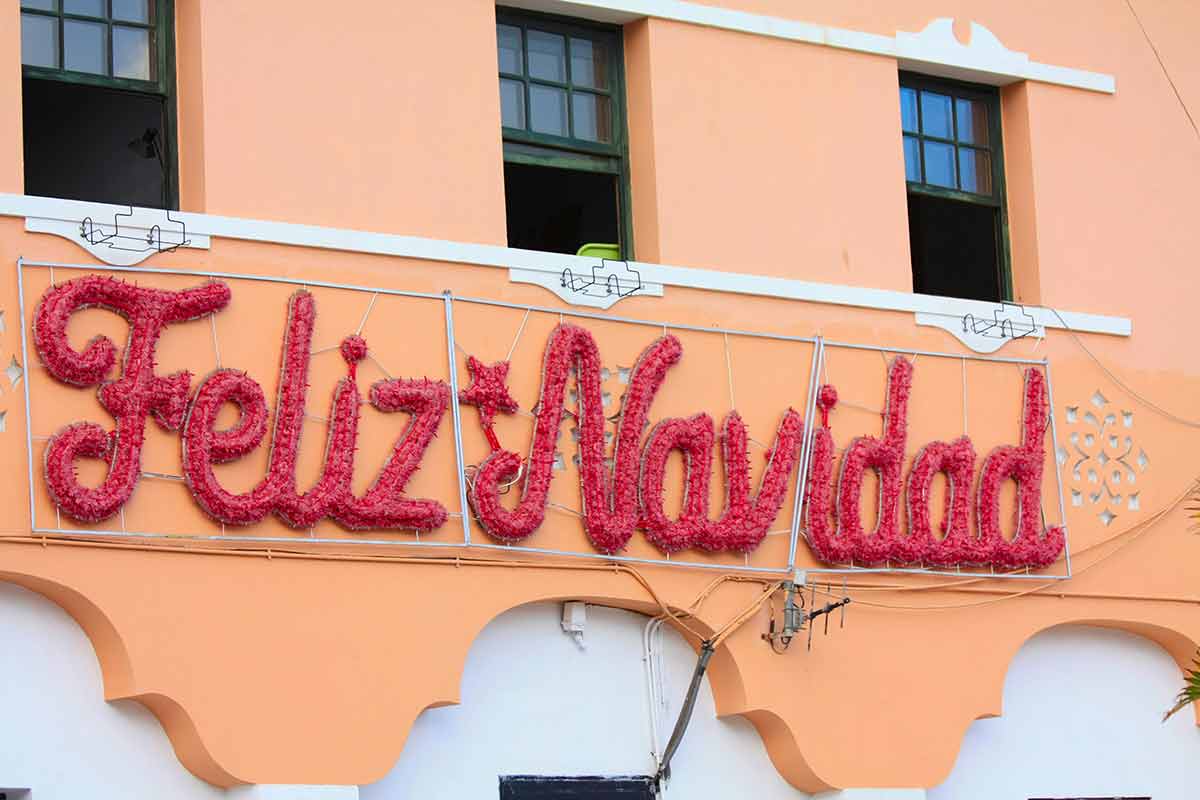
Wishing someone a Merry Christmas is a wonderful thing to do, even to strangers you encounter. A Merry Christmas to your bus driver, waitress, or the person bringing you coffee can make someone’s day.
To say Merry Christmas in Spain, wish someone ‘Feliz Navidad’. The literal translation of this is Happy Christmas.
There are other Christmastime greetings that may be useful when spending Christmas in Spain.
You may wish someone ‘Felices Fiestas’ (Happy Holidays), ‘Feliz Año Nuevo’ (Happy New Year), or to show affection, ‘Con mucho cariño, te deseo una Feliz Navidad (with all of my love, I wish you a Happy Christmas).
Christmas Food
8- Roscón de Reyes
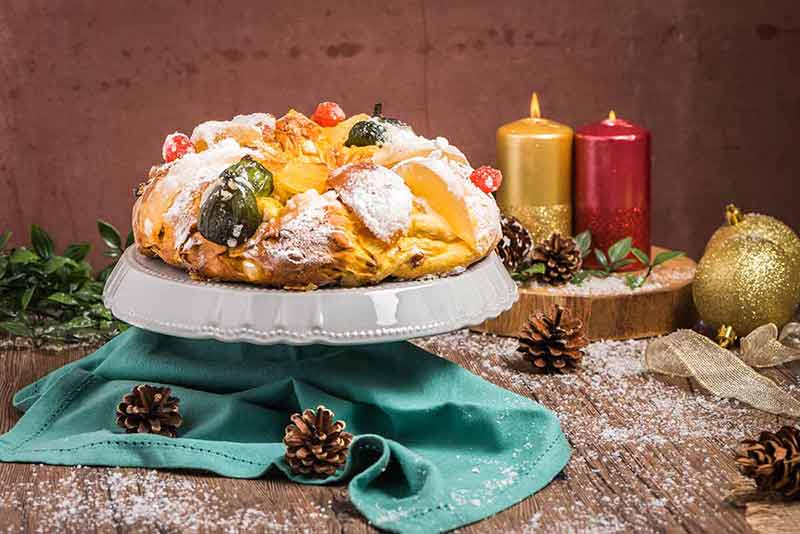
Roscón de Reyes is a traditional Spanish Christmastime treat.
The traditional cake is made from sweet bread, like a light buttery brioche, filled with whipped cream and topped with sugar and colourful candied fruits.
Crushed almonds are also used to decorate this delicious Christmas treat. The bread is often flavoured with orange extract or orange blossom water.
It is designed to replicate a crown.
Traditionally a small king or queen figurine is placed within the cake and whoever finds it will receive luck and blessings the whole year.
Additionally, a bean is hidden inside.
The recipient of the bean must buy the Roscón de Reyes the following year.
9- Turrón
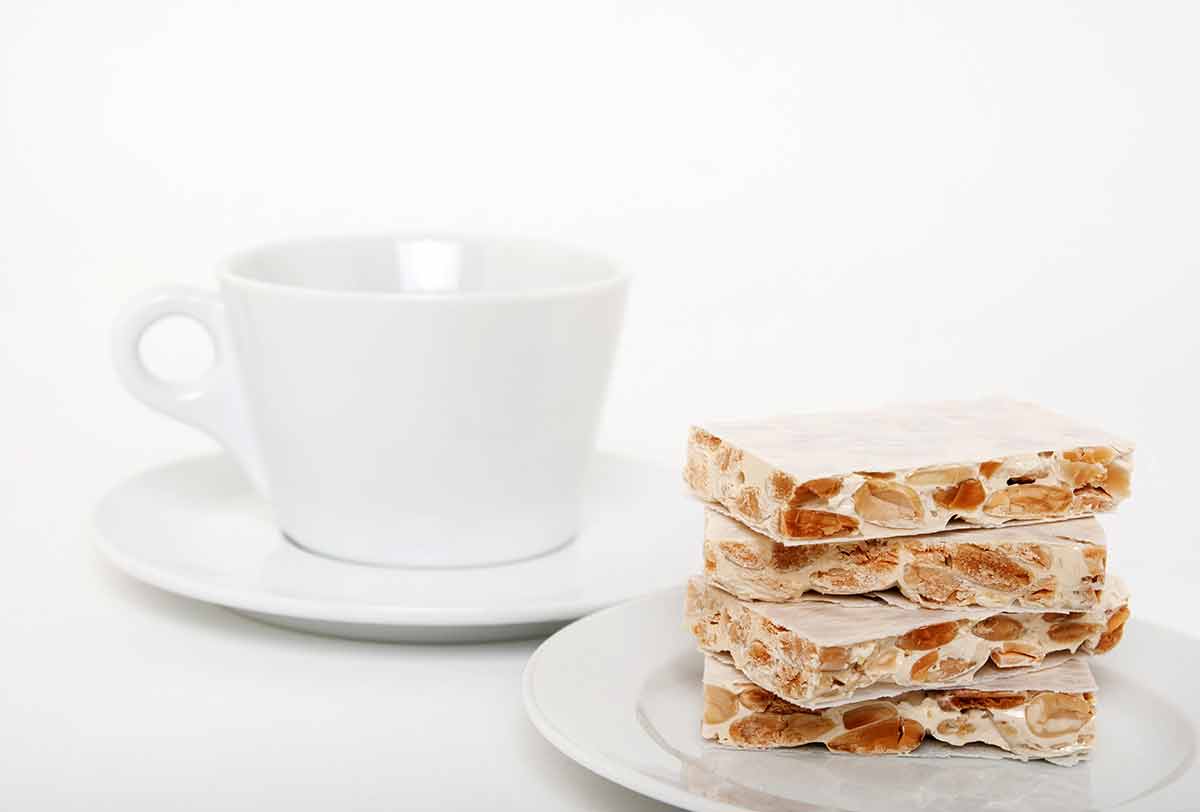
Turrón is possibly the most well-known Spanish Christmas food. It is a sweet eaten throughout the country during the festive period.
Turrón is a type of nougat traditionally made from almonds.
It originates in Alicante but is sold across the country.
Different types of turrón are available, with each region adding their own twist.
Some are flavoured with other nuts and dried fruits or flavoured to taste like Spanish desserts.
Purchase some turrón at a Christmas market as a tasty souvenir of your visit or as gifts for family and friends.
10- Polvorónes and Mantecados
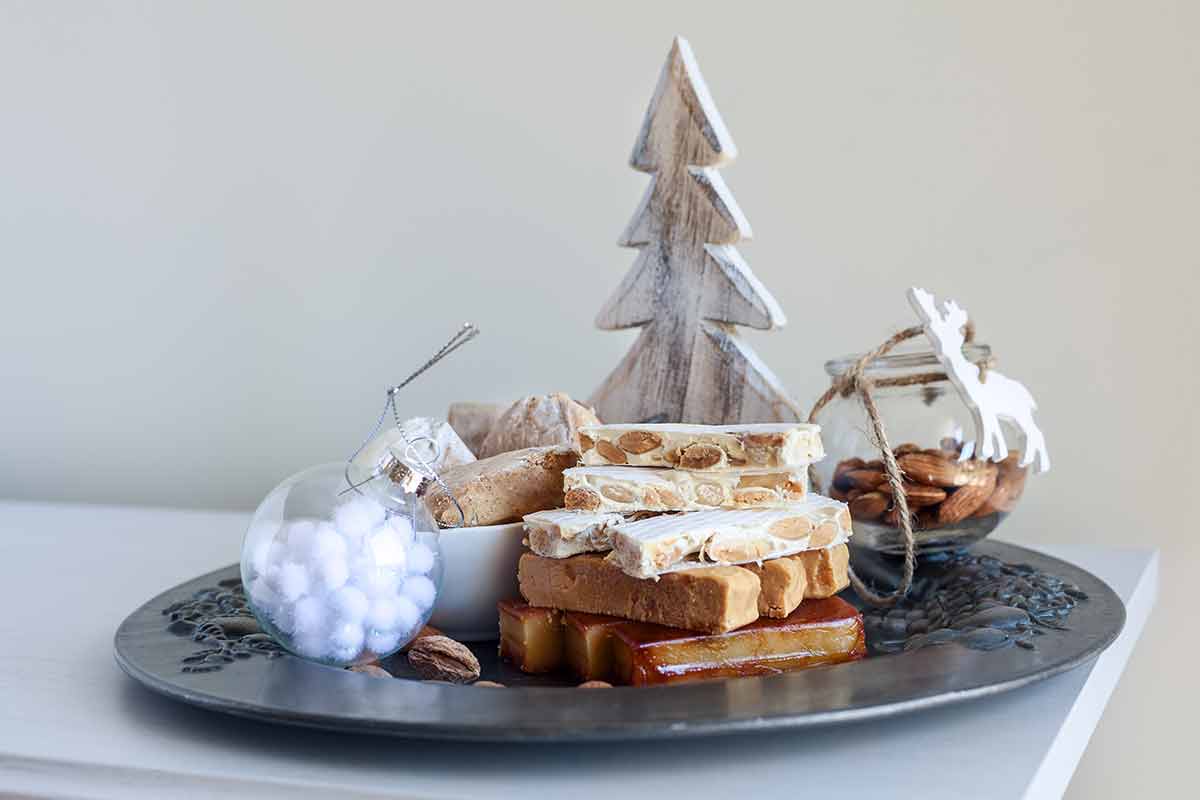
Polvorónes and Mantecados are popular sweets with a long history.
They are often found in supermarkets and delis wrapped in brightly coloured wrappers.
Mantecados date back to the 16th century.
These small biscuits are made from lard and are very rich and crumbly. They are most popular in Antequera.
Polvorónes are a type of mantecados but are more powdery in consistency and dusted in a generous coating of powdered sugar.
These sweet treats are popular in Tordesillas, Cádiz and Almería.
11- Seafood
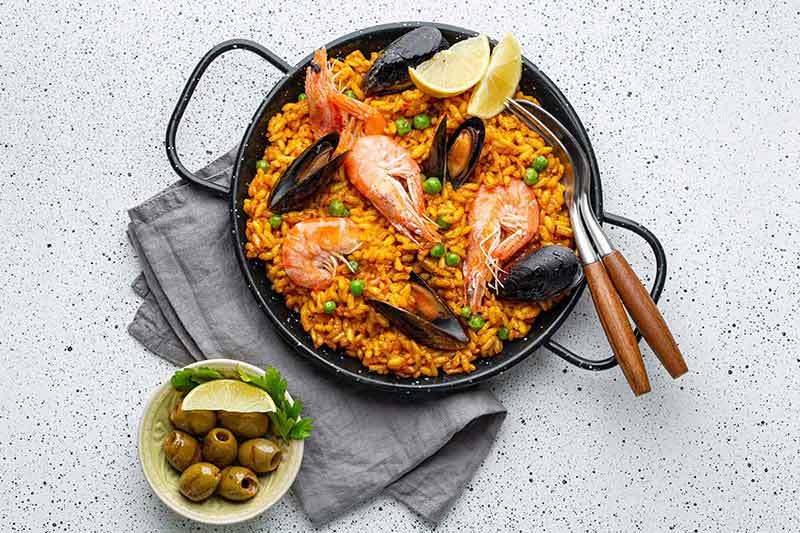
Fish and shellfish are frequently found on the Christmas menu across Spain.
They are often served instead of turkey, a tradition in other countries.
Lobster and prawns are the most popular. Fish and shellfish are sometimes served as a seafood soup starter before the main meal.
12- Cochinillo Asado
Cochinillo Asado is a roast suckling pig dish that is particularly popular in Castilla y Léon.
The suckling pig is cooked for a long time at a low temperature creating succulent and juicy meat with a brown and crisp skin.
It is often cooked on a bed of onions and potatoes, which are served alongside the meat and add additional flavourings to the dish.
13- Galets
Galets is a soup dish served in Catalonia. This dish is very popular and is usually found in most homes during Christmas.
The dish is made of galets or huge pasta shells stuffed with mincemeat and served in a light meaty broth.
Christmas Decorations
14- Portal de Beléns
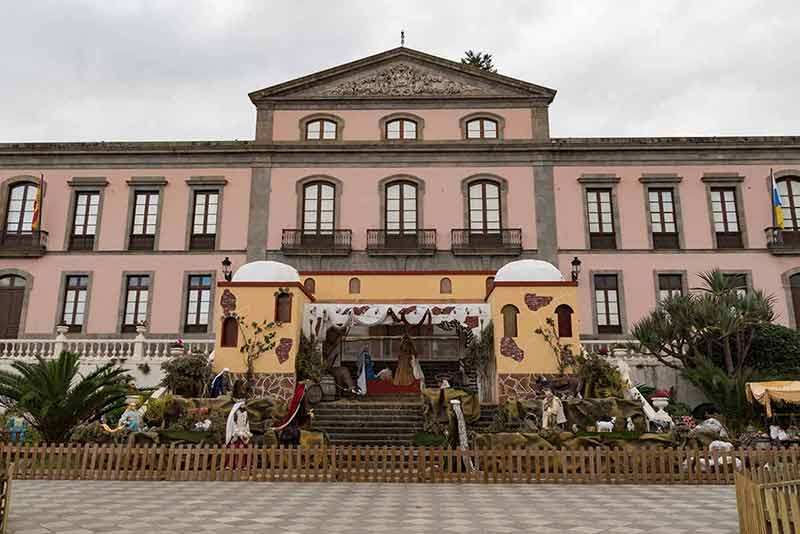
Portal de Beléns is one of Spain’s most popular Christmas decorations and traditions.
Portal de Beléns translates to ‘stable of Bethlehem’ and is based on the traditional nativity scene found in many homes, churches and towns across the world.
Portal de Beléns goes one step further than the traditional small scene of a stable.
Each nativity scene is vastly expanded in Spain to incorporate houses, markets, farms, and many characters and animals.
These traditional scenes are displayed in town squares, inside market halls, in shop windows, and of course, within the home.
Some Spanish cities take their Portal de Beléns to the next level and have living displays with live actors and animals.
15- Caga Tió
This quaint Catalonian Christmas tradition is a favourite decoration for the home of many families.
Many cities and towns across the region sell Caga Tió fully assembled and decorated.
Make your own from a log decorated with legs, a happy face, a blanket and a traditional Catalan hat known as a barretia.
This friendly log makes a great Christmas souvenir for families with young children or for those who fall for this colourful character.
16- Tree Decorations
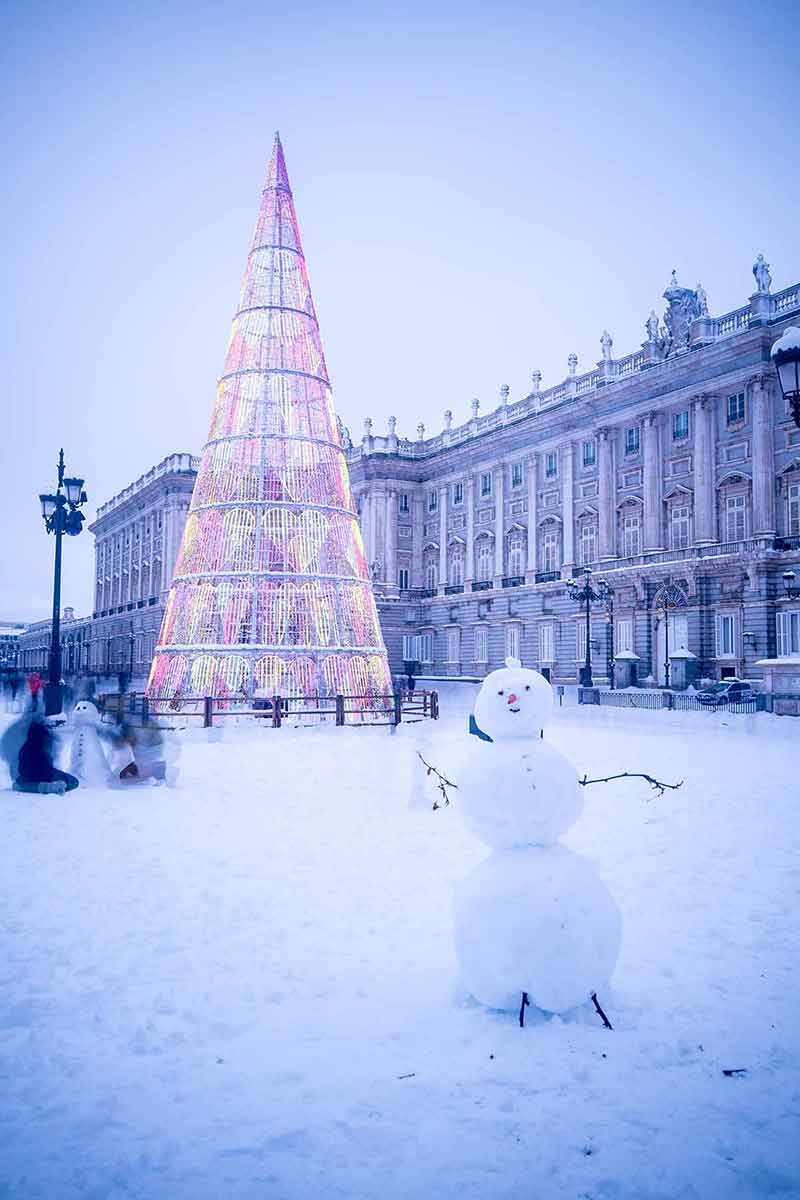
Spanish households decorate their homes with a Christmas tree.
As with other countries, tree decorations vary yearly, depending on trends.
Many homes choose to include some religious-based Christmas decorations alongside these trends.
Religious-themed Christmas tree decorations include angels, the Three Kings, stars, church bells, and miniature nativity scenes.
Traditional Christmas Songs In Spain
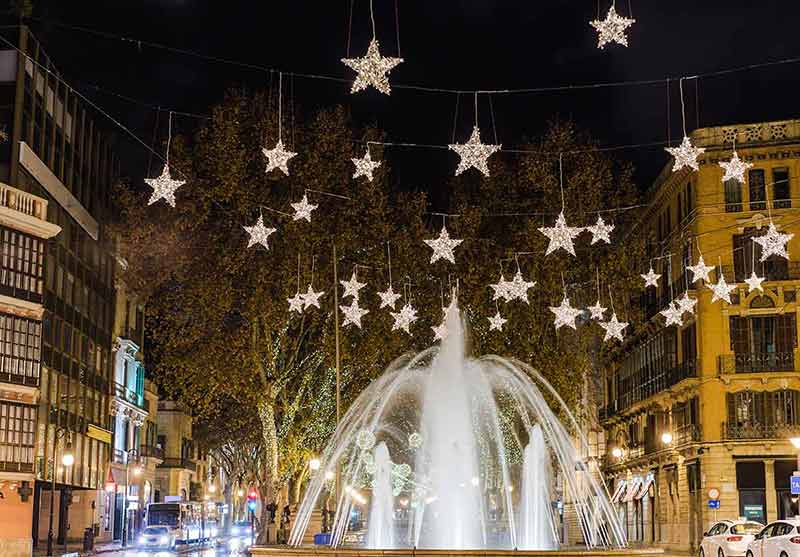
Christmas carols are known as villancicos in Spain.
Children mostly sing these carols at school or in church services.
Villancicos’ origins begin in the Middle Ages.
They took the form of poems or music. Today, the term is used to describe all traditional songs sung at Christmas.
In southern Spain, flamenco plays a key role in the rhythm of the villancicos.
Pandereta and zambomba, two instruments, also form part of the Christmas tradition.
Traditional Christmas songs sung in Spain include Los Peces en el Rio.
This villancicos is one of the most popular in Spain.
The title means ‘a fish in the river’.
The song’s story focuses on the Virgin Mary as she washes newborn clothes in a river.
Campanas de Belén recounts key moments from the birth of Jesus.
The song opens with the announcement of his birth, followed by the celebration and, eventually, the shepherds arriving in Bethlehem with their gifts.
Ya Vienen los Reyes focuses on the Three Kings and their gifts, which were given to the baby Jesus on 6 January.
The song explains the gifts brought by the kings when they arrived in Bethlehem.
Best places to spend Christmas in Spain
Spain is an incredibly beautiful and varied country with different traditions and celebrations throughout the year.
Each city or region celebrates Christmas and Three Kings Day differently, giving you plenty of options for your Christmas in Spain.
17- Valencia
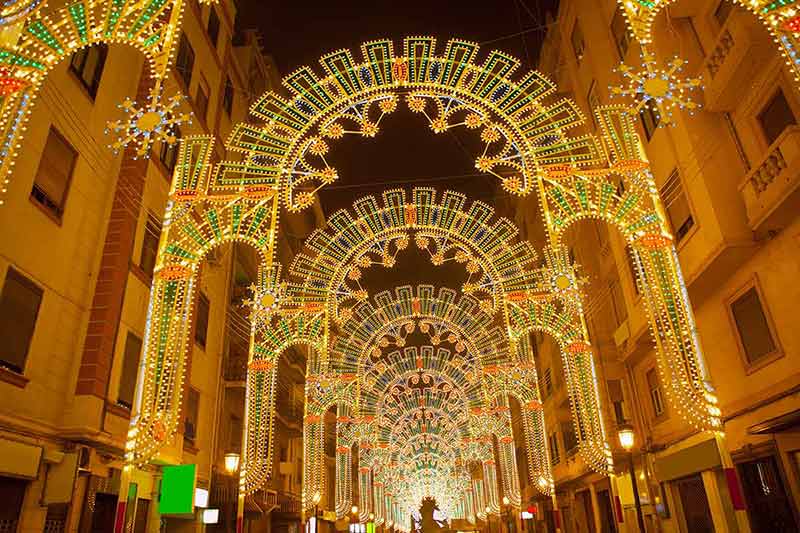
Valencia is an incredible city to visit, no matter the time of year.
The city is filled with sparkling lights and decorations and the Christmas spirit is truly in the air.
Across the city, there are many Portal de Beléns.
The most popular nativity scene is in the Plaza del Ayuntamiento and many smaller Portal de Beléns an be found in supermarkets, inside the cathedral, the market and in some museums.
Three Kings Day is by far the biggest Christmas celebration in Valencia.
On 5 January, the Three Kings disembark a boat at the Port of Valencia before following a parade route through the city to Plaza del Ayuntamiento.
Once they arrive at the plaza, the Kings stand on the balcony of City Hall and speak to the crowds.
Then, the doors of City Hall open and children can go and meet the Kings and share what gifts they would like to receive with them.
18- Segovia
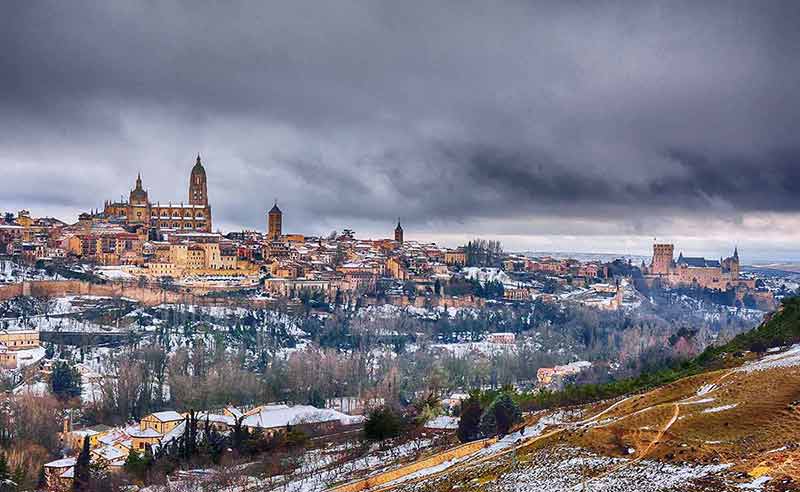
Located just 30 minutes from Madrid, Segovia is worth visiting during Christmas.
This city is famous for its Roman aqueduct that runs through the city centre, an impressive cathedral and the Alcazar de Segovia, a beautiful castle on the water.
During Christmas, the city is covered in bright festive lights.
In front of the aqueduct, the city places a large Christmas decoration on a plinth lit up in colourful lights.
In the past, the decorations have included baubles, snow globes, and a Portal de Beléns.
19- Madrid
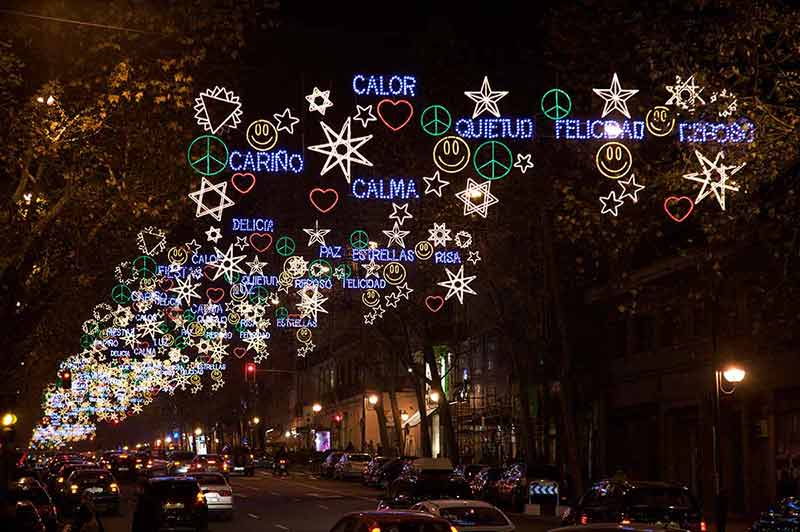
Madrid, Spain’s capital city, is an excellent destination for spending Christmas in Spain as it is famous for its Christmas celebrations.
The entire city is transformed into a winter wonderland in November until the Three Kings Day celebrations are over.
The streets are lined with beautiful Christmas lights and glowing decorations.
Madrid has excellent Christmas markets filled with gifts, food and warming drinks.
The largest Christmas market in Madrid is at Plaza Mayor, the city’s largest square.
Look for Madrid’s Portal de Beléns exhibited across the city, with the largest and most famous being at Cibeles Palace and the Real Casa de Correos.
For families, visit Plaza de Legazpi to go ice skating, or for a more magical skating experience, head to Palacio de Cibeles’ Glass Gallery.
If you are staying in Madrid over Three Kings Day, take part in the biggest Christmas event in the city, the Cabalgata de Reyes.
This event on 5 January features a parade of floats that includes the Three Kings, music, dancers, performances, and plenty of fun.
20- Barcelona
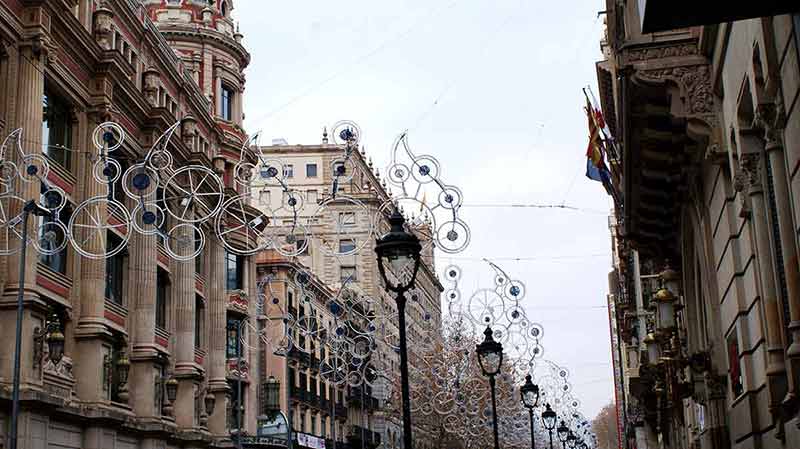
The capital of the Catalonia region is a must-visit Spanish city during Christmas.
The region is fiercely proud of its traditions and heritage.
Be sure to wish people’ Bon Nadal’, which means ‘Merry Christmas’ in Catalan, the regional dialect spoken here.
Barcelona’s streets are decorated with extravagant Christmas light displays like all major cities celebrating Christmas.
Portal de l’Angel and La Rambla are some of the most popular streets to visit to see the lights.
Barcelona is home to many fascinating Christmas traditions.
When visiting the Christmas markets look out for your own Caga Tió to take home with you.
These cheeky-faced log creatures will put a smile on your face come Christmas Eve.
Christmas markets in Barcelona are a great way to stock up on gifts and stocking fillers or to try local delicacies.
Visit the largest Christmas Market, Fira de Santa Llúcia, underneath the cathedral. This Christmas market has been running for more than 225 years.
If you are visiting during mid-December, your trip might line up with the Father Christmases Parade, where hundreds of children dress as Santa Claus and parade through the streets.
Looking for something fun to do this Christmas? Try these:
Plan Your Trip

Rent A Car – Find the best car rental rates at Discover Cars. They compare car hire companies to provide you with the best deal right now.

Find A Hotel – If you’re curious about this article and are looking for somewhere to stay, take a look at these amazing hotels.
